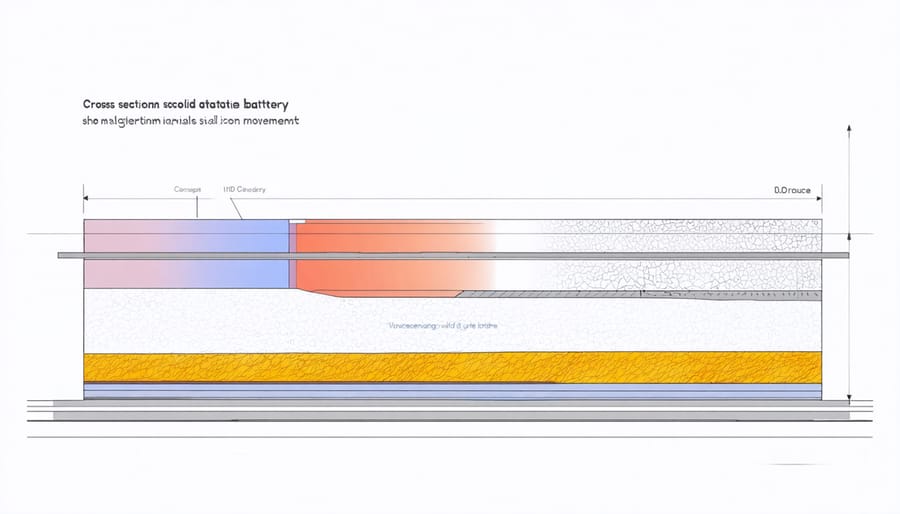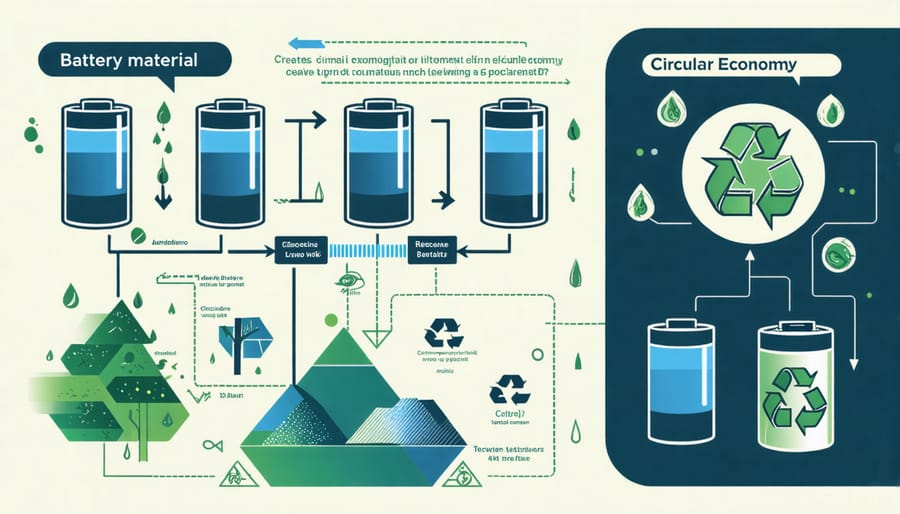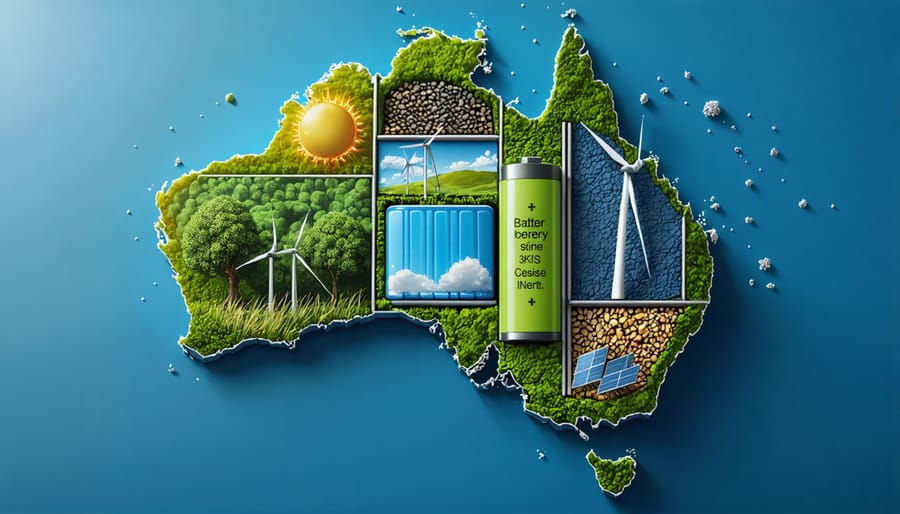The race to revolutionize energy storage stands at a pivotal moment as next-generation batteries emerge to power Australia’s clean energy revolution. Beyond lithium-ion technology, a new wave of innovative materials and designs promises to transform how we capture, store, and deploy renewable energy. From solid-state batteries that deliver unprecedented safety and energy density to sustainable sodium-ion alternatives that eliminate dependency on rare earth minerals, these breakthrough technologies are reshaping our energy landscape.
Australian researchers and manufacturers stand at the forefront of this transformation, developing solutions that combine cutting-edge science with practical applications. These advanced energy storage systems not only offer superior performance and longer lifespans but also address critical environmental concerns by incorporating recyclable materials and reducing carbon footprints throughout their production cycle.
As our nation accelerates its transition to renewable energy, these next-generation batteries represent more than just technological advancement – they embody our commitment to a sustainable future. Their development signals a fundamental shift in how we power our homes, businesses, and transportation systems, promising to unlock the full potential of renewable energy sources while ensuring energy security for generations to come.
Breakthrough Battery Materials Reshaping Energy Storage
Solid-State Electrolytes
The shift from liquid to solid-state electrolytes marks one of the most promising developments in battery technology. These innovative materials are transforming how we think about energy storage, offering a safer and more efficient alternative to traditional lithium-ion batteries.
Unlike conventional liquid electrolytes, solid-state variants eliminate the risk of leakage and fire, making them particularly appealing for Australia’s harsh climate conditions. These materials, typically made from ceramics or solid polymers, create a robust barrier between the battery’s positive and negative electrodes while still allowing ions to flow efficiently.
Research centres across Australia, including the University of Queensland and Deakin University, are at the forefront of developing new solid electrolyte materials. Their work focuses on improving ionic conductivity and mechanical stability, two critical factors that will determine the widespread adoption of this technology.
The benefits extend beyond safety. Solid-state electrolytes enable higher energy densities, potentially doubling or even tripling the range of electric vehicles. They also promise longer battery life and faster charging capabilities, addressing key concerns of both consumers and industry professionals.
For our renewable energy future, solid-state electrolytes represent a game-changing technology. They’re particularly valuable for grid storage applications, where safety and longevity are paramount. As we continue to harness more solar and wind power, these advanced materials will play a crucial role in storing and distributing clean energy across the nation.

Bio-Derived Components
In a remarkable shift towards sustainability, researchers are turning to nature’s own materials to revolutionise battery technology. Australia’s abundant biomass resources, from eucalyptus trees to agricultural waste, are proving to be valuable sources for next-generation battery components. These bio-derived materials offer a sustainable alternative to traditional mineral-based components while maintaining high performance standards.
One promising development involves using lignin, a natural polymer found in gum trees and other woody plants, as a precursor for carbon-based electrodes. This abundant waste product from paper manufacturing is being transformed into high-performance battery materials right here in Australian laboratories. Similarly, cellulose from agricultural residues is being converted into advanced separators and electrolyte materials, reducing the battery industry’s reliance on synthetic polymers.
Seaweed-based materials are making waves in the battery world, with Australian researchers successfully developing alginate-based electrolytes that show excellent ionic conductivity. These marine-derived components not only perform well but also address the end-of-life concerns associated with conventional batteries, as they’re naturally biodegradable.
Perhaps most exciting is the development of organic electrode materials from fruit and vegetable waste. These bio-derived components not only give a second life to food industry by-products but also create batteries that are safer and more environmentally friendly than their conventional counterparts. Local initiatives are already scaling up these technologies, showcasing Australia’s leadership in sustainable battery innovation.
Australian Innovation in Battery Manufacturing

Local Research Breakthroughs
Australian research institutions are making remarkable strides in battery technology, positioning our nation at the forefront of energy storage innovation. The University of Queensland has developed a breakthrough sodium-ion battery that promises to be both more affordable and environmentally friendly than traditional lithium-ion alternatives. Their prototype has already demonstrated impressive charge retention, maintaining 95% capacity after 1000 cycles.
Meanwhile, researchers at Monash University have pioneered a revolutionary zinc-bromide battery technology that’s completely fire-resistant and can function effectively in extreme temperatures. This innovation addresses critical safety concerns while offering a storage solution particularly suited to Australia’s harsh climate conditions.
CSIRO’s battery research team in Melbourne has made significant progress with their ultra-thin battery technology, which uses advanced materials to create flexible power sources. This development could revolutionise portable electronics and integrate seamlessly with renewable energy systems.
The University of Sydney’s energy storage laboratory has successfully created a hybrid supercapacitor that combines the rapid charging capabilities of capacitors with the energy density of batteries. This technology shows promise for electric vehicle applications, potentially enabling charging times of less than 10 minutes.
In Perth, researchers at Curtin University have developed new electrode materials using abundant Australian minerals, reducing dependency on imported resources. Their work demonstrates how local resources can support sustainable battery production while strengthening Australia’s position in the global supply chain.
These achievements showcase Australia’s capacity for innovation in energy storage solutions, with practical applications already being tested in real-world conditions across the country.
Industry Applications
Next-generation batteries are revolutionising multiple sectors across Australia, demonstrating the practical impact of Australian battery manufacturing innovations in real-world applications. In the mining sector, companies like Fortescue Metals Group are implementing advanced lithium-ion batteries in their haul trucks, significantly reducing diesel consumption and operational costs while cutting emissions.
The renewable energy sector has emerged as a primary beneficiary, with utility-scale battery storage facilities becoming increasingly common. The Hornsdale Power Reserve in South Australia, affectionately known as the “Big Battery,” showcases how advanced battery technology can stabilise the grid and store excess solar and wind energy for later use.
Electric vehicle adoption is gaining momentum, with fleet operators leading the charge. Australia Post has begun transitioning its delivery vehicles to electric alternatives powered by next-generation batteries, while major supermarket chains are exploring battery-electric refrigeration systems for their delivery trucks.
In agriculture, farmers are incorporating battery storage systems to power irrigation systems and farm equipment, reducing reliance on diesel generators. These systems, paired with solar installations, are helping rural businesses achieve energy independence and lower operating costs.
The telecommunications industry is another significant adopter, with companies installing advanced battery systems at mobile tower sites to ensure uninterrupted service during power outages. These implementations are particularly crucial in remote areas where grid reliability can be challenging.
These real-world applications demonstrate how next-generation batteries are not just theoretical improvements but practical solutions driving Australia’s transition to a more sustainable and efficient future.
Environmental Benefits and Sustainability
Reduced Environmental Impact
Next-generation batteries are leading the charge in reducing our environmental footprint, offering a cleaner alternative to traditional energy storage solutions. Unlike conventional lithium-ion batteries, which often contain toxic materials and require environmentally intensive mining processes, these innovative power sources are designed with sustainability at their core.
A significant breakthrough comes from the development of organic electrode materials, which can be derived from renewable resources and are biodegradable at the end of their life cycle. These materials not only reduce the need for heavy metal mining but also decrease the carbon emissions associated with battery production by up to 60%.
Australian researchers have made remarkable progress in developing sodium-ion batteries, which eliminate the need for cobalt and nickel mining – two processes that traditionally carry heavy environmental impacts. These alternatives use abundant materials that can be sourced locally, reducing the carbon footprint associated with global transportation.
The manufacturing processes for next-generation batteries are also becoming more environmentally friendly. New water-based production methods are replacing toxic solvents, while advanced recycling technologies are making it possible to recover and reuse up to 95% of battery materials. This circular approach significantly reduces waste and the demand for raw materials.
Most importantly, these batteries are designed for longevity, with some models showing minimal degradation even after thousands of charge cycles. This extended lifespan means fewer replacements and less electronic waste in our landfills, contributing to a more sustainable future for Australia and beyond.
Circular Economy Integration
The shift towards a circular economy in battery production represents a crucial step in sustainable energy storage. Australian manufacturers are leading the way with innovative battery recycling initiatives that recover valuable materials from end-of-life batteries, significantly reducing environmental impact and resource consumption.
Next-generation batteries are being designed with recyclability in mind from the outset. Manufacturers are incorporating easily separable components and implementing standardised designs that facilitate efficient dismantling and material recovery. This approach not only minimises waste but also creates new economic opportunities within the recycling sector.
The adoption of bio-based materials and water-based manufacturing processes is revolutionising battery production. These innovations reduce toxic waste and lower the carbon footprint of battery manufacturing. Some Australian companies are pioneering the use of organic electrode materials that can be safely returned to the environment at the end of their life cycle.
Urban mining, the practice of recovering valuable materials from used batteries, is gaining traction across the country. This approach not only reduces reliance on raw material extraction but also creates local jobs and supports Australia’s resource security. Forward-thinking businesses are establishing collection networks and processing facilities, creating a robust infrastructure for sustainable battery management.
The integration of circular economy principles in battery development is proving that environmental responsibility and economic growth can go hand in hand, paving the way for a more sustainable energy future.

Future Implications for Australia’s Energy Landscape
The integration of next-generation batteries into Australia’s energy infrastructure promises to revolutionize how we harness and utilize renewable power. As smart energy storage systems become more sophisticated and affordable, our nation stands at the threshold of a transformative energy future.
By 2030, experts predict that advanced battery technologies will enable Australia to achieve up to 50% renewable energy penetration across the national grid. This shift will particularly benefit remote communities, where reliable energy storage has traditionally been a challenge. The implementation of these new battery systems will create energy independence and resilience, reducing reliance on diesel generators and fostering sustainable development in rural areas.
The economic implications are equally promising. As battery manufacturing capabilities expand within Australia, we’re looking at the potential creation of thousands of skilled jobs across the supply chain. The battery industry could contribute an estimated $7.4 billion annually to the Australian economy by 2030, positioning us as a global leader in energy storage innovation.
For households and businesses, next-generation batteries will revolutionize energy consumption patterns. Imagine being able to store surplus solar power with 40% more efficiency than current systems, while using materials that are more abundant and environmentally friendly. This advancement will make renewable energy more accessible and cost-effective for average Australians.
The environmental benefits extend beyond reduced carbon emissions. These new battery technologies require less mining of rare earth materials and offer improved recyclability. This aligns perfectly with Australia’s commitment to sustainable development and our goal of becoming a renewable energy superpower.
Local councils and state governments are already preparing for this transition by updating infrastructure and planning regulations to accommodate these new storage solutions. This forward-thinking approach ensures that Australia will be ready to embrace and maximize the benefits of next-generation battery technology as it becomes available.
As Australia stands at the forefront of the global energy transition, next-generation battery materials represent more than just technological advancement – they embody our commitment to a sustainable future. These innovative solutions are revolutionizing how we store and use energy, offering unprecedented possibilities for renewable energy integration and reducing our carbon footprint.
The transformation we’re witnessing in battery technology goes beyond incremental improvements. From solid-state batteries that promise enhanced safety and longer lifespans to sustainable materials that minimize environmental impact, these advances are reshaping our energy landscape. Australian researchers and industry leaders are playing a crucial role in this revolution, leveraging our natural resources and technical expertise to develop solutions that work for our unique conditions.
The future of energy storage in Australia looks increasingly bright. As these new technologies mature and become more accessible, we’re moving closer to a future where reliable, sustainable energy is available to all Australians. The economic benefits are substantial, from job creation in manufacturing and research to reduced energy costs for consumers and businesses.
Most importantly, next-generation batteries are helping us build a more resilient and sustainable energy infrastructure. By enabling greater renewable energy adoption and reducing our dependence on fossil fuels, these innovations are crucial tools in our fight against climate change. The path forward is clear – by embracing these technologies, Australia can lead the way in creating a cleaner, more sustainable future for generations to come.

